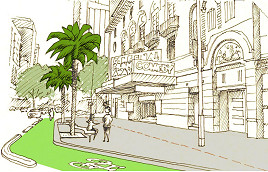Speaking up - Communicating in vertical villages
By Janette Corcoran
The sheer number of people who reside in “One Big Residence” means that vertical dwellers live amongst strangers - or so many popular portrayals of high-rise, high-density living would have you believe.
Often our lifestyle is criticised for anonymous interactions occurring in towers of isolation where human contact is either deficient or proactively avoided. We (apparently) are very anxious about our in-house stranger-danger, communicating our fears verbally and non-verbally. And, perhaps more alarmingly, we are also viewed as fearful of contracting communicable diseases from these strangers (as air and touch borne viruses spread more rapidly when many people share hallway air, door handles and elevator buttons).
Added to this, the array of different nationalities in our towers have been noted by academics Edgar Liu (UNSW), Hazel Easthope (UNSW) and Christina Ho (UTS) as adding to our tension as differences in culture, language and lifestage may exacerbate resident conflicts.
Who could fail to be attracted to such a lifestyle?
Yet, perception is all in the framing.
Stated another way, having “little in common” becomes “richly diverse”, something we are encouraged to celebrate. And differences in lifestyle and lifestage become opportunities for vibrant exchanges between people on international secondments, retiree couples, solo women, young families and travellers.
However, there is no denying there are tensions within our vertical villages which is evident in the number of trips to VCAT and the busyness of dispute resolution committees.
Added to this, there is a noticeable difference amongst residents’ knowledge about their building: how it operates, its history and the planned happenings (ie when is that carpet being replaced?). And it is unfortunately often true that our villages have all too few areas to mingle and little social infrastructure to support these interactions (such as in-building clubs).
This means that building-based communication systems become extremely important as they are the key means of keeping residents informed (if not engaged!).
Yet, the communication systems within our vertical villages are often inadequate, comprising out-of-date websites, clunky portals, partial email or phone lists and mail boxes (which require time consuming hand delivery). Added to this, not too many in building management boast strong communication skills (let alone PR!), which has led to issues about the type and tone of messaging. Indeed, there continue to be instances rousing the ire of residents due to the wrong message being delivered in the wrong way – such as was the case with a public and pictorial instruction to keep our tighty-whities off the balcony.
What do to?
Unsurprisingly, this failure-to-communicate has been noticed by some of the larger strata management firms and there is a move towards incorporating communication as part of their services. It does not take much effort to find offers of “powerful integrated software” which promise to provide access to streamlined community resource hubs that collect resident information and, in return, communicate in accordance with stated preferences.
For those vertical villages thinking about such offers, there are a few things to consider, starting with the data. Key issues include:
Who owns this data? (the owners’ corporation or the strata management firm) and what happens if/when there is a change of provider?
Security (from multiple angles). There are issues of access (who and under what conditions), usage (initial and secondary/unintended purposes), storage (format, length), etc;
And yes, there is also dreaded meta data!
Answers to these questions will be critical to the uptake of these systems by residents who will not participate if not convinced about their robustness.
Perhaps then, the work of students from the University of Adelaide might be useful. They have developed Communitilink, a new platform that connects apartment residents and building managers, and it has taken out the 2017 eChallenge major prize for early-stage entrepreneurial ventures.
Developed by Aaron Smedley, Tom Welsby and Josh Marcus, Communitilink is aimed at supporting high-density living through a series of user engagement platforms, allowing building managers and residents to communicate about maintenance, news and other property and facilities issues. The platforms are also designed to encourage residents to interact socially. The developers claim Communitilink as the only service of its kind, and are at pains to have it seen as ensuring not only a more convenient way of connecting but also as a safe and trustworthy way of doing so.
What is not in doubt is that the challenge of communication and engagement will be increasingly important to the fabric of our vertical lifestyles and it is these types of social innovations that will further evidence the transformation of “isolation towers” to vertical villages.
If you would like links to the material mentioned, please visit and like SkyPad Living on Facebook.

Council endorses office tower at Flinders Lane despite querying car park demolition



 Download the Latest Edition
Download the Latest Edition